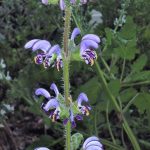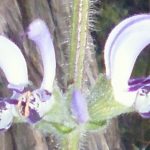Salvia indica: is a clumping perennial 20-30 cm H with large felty lobed leaves and spikes of beautifully marked purple flowers in spring.

Salvia indica is an attractive clump forming perennial.
Flowers: are falcate in shape, with the mauve hood creating a large space between lower lobes and the sickle shaped hood. The exerted stigma is also mauve coloured.
The bottom middle lobe is beautifully marked in purple and white with brown edging, but the two side lobes are a deep purple. This colourful combination of colours helps to attract and guide the bees and other insects into the flower itself.
These flowers appear ate winter, early spring in whorls of 6-8 flowers, all spaced well apart on a green hairy stem, well above the foliage to attract passing insects.
Calyces: are green, ribbed, hairy with pointed lobes
Leaves: are large, grey green, with felty hairs on both surfaces. These are shaped into sharp triangular lobes. Most of the leaves form a basal clump at the bottom of the flowering spikes.
Although the leaves diminish quite a bit during the colder months, they begin to grow again in late winter / early spring before sending up the flower spikes.
Salvia indica prefers a sunny position with good deep soil that hold moisture during the hot dry summer months but drains well.
Plant S. indica with other purple, blue, white or pink herbaceous or clumping perennials that like an open position in the sun. This is a tough hardy perennial in the summer months if well mulched to keep the root area cool.
As the leaves are felty, this Salvia tolerates the winter cold and frost whilst growing, getting ready to send up a flower spike at the beginning of spring. The flowers only last a short time, so multiple spikes are needed during late spring and early summer.
When flowering is finished and seed collected, cut down the stems, clean away old leaves, tide the clump, feed and much around the base to keep the roots and crown cool until it begins to grow again during winter.
Propagation: is usually by seed sown in early autumn, so the plant is advanced by spring to send up flower spikes.
Not always available
Back to Varieties



